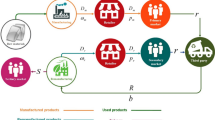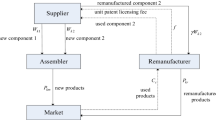Abstract
Remanufacturing has been widely recognized in practice. However, the low acceptance of remanufactured products deeply hinders the performance of remanufacturing. Recently, trade-in programs are growing in popularity for selling remanufactured products to promote consumptions. In this paper, under the constraint of consumer participation, we investigate the conditions under which a trade-in program for remanufactured products should be adopted and how to optimize the pricing and production decisions. Cannibalization between new and remanufactured products has been analyzed for both primary and replacement markets.


Similar content being viewed by others
References
Abbey, J.D., Blackburn, J.D.: Optimal pricing for new and remanufactured products. J. Oper. Manag. 36, 130–146 (2015)
Atasu, A., Sarvary, M., Wassenhove, L.N.V.: Remanufacturing as a marketing strategy. Manag. Sci. 54(10), 1731–1746 (2008)
Atasu, A., Guide, J.V.D.R., Van Wassenhove, L.N.: So what if remanufacturing cannibalizes my new product sales? Calif. Manag. Rev. 52(2), 56–76 (2010)
Cai, X.Q., Lai, M.H., Li, X., Li, Y.J., Wu, X.Y.: Optimal acquisition and production policy in a hybrid manufacturing/remanufacturing system with core acquisition at different quality levels. Eur. J. Oper. Res. 233, 374–382 (2014)
Desai, P.S., Purohit, D.: Competition in durable goods markets: the strategic consequences of leasing and selling. Mark. Sci. 18, 42–58 (1999)
Ferrer, G., Swaminathan, J.M.: Managing new and differentiated remanufactured products. Eur. J. Oper. Res. 203(2), 370–379 (2010)
Gan, S.S., Pujawan, I.N., Suparno Widodo, B.: Pricing decision for new and remanufactured product in a closed-loop supply chain with separate sales-channel. Int. J. Prod. Econ. 190, 120–132 (2016)
Guide Jr., V.D.R., Li, J.: The potential for cannibalization of new products sales by remanufactured products. Decis. Sci. 41, 547–572 (2010)
Han, X., Yang, Q., Shang, J., Pu, X.: Optimal strategies for trade-old-for-remanufactured programs: receptivity, durability, and subsidy. Int. J. Prod. Econ. 193, 602–616 (2017)
Pei, J., Liu, X.B., Fan, W.J., Pardalos, P.M., Lu, S.J.: A hybrid BA-VNS algorithm for coordinated serial-batching scheduling with deteriorating jobs, financial budget, and resource constraint in multiple manufacturers. Omega (2017). https://doi.org/10.1016/j.omega.2017.12.003
Pei, J., Cheng, B.Y., Liu, X.B., Pardalos, P.M., Kong, M.: Single-machine and parallel-machine serial-batching scheduling problems with position-based learning effect and linear setup time. Ann. Oper. Res. (2017). https://doi.org/10.1007/s10479-017-2481-8
Pei, J., Liu, X.B., Pardalos, P.M., Migdalas, A., Yang, S.L.: Serial-batching scheduling with time-dependent setup time and effects of deterioration and learning on a single-machine. J. Glob. Optim. 67(1), 251–262 (2017)
Pei, J., Liu, X.B., Liao, B.Y., Pardalos, P.M., Kong, M.: Single-machine scheduling with learning effect and resource-dependent processing times in the serial-batching production. Appl. Math. Model. (2017). https://doi.org/10.1016/j.apm.2017.07.028
Pei, J., Liu, X.B., Pardalos, P.M., Fan, W.J., Yang, S.L.: Single machine serial-batching scheduling with independent setup time and deteriorating job processing times. Optim. Lett. 9(1), 91–104 (2015)
Pei, J., Pardalos, P.M., Liu, X.B., Fan, W.J., Yang, Shanlin: Serial batching scheduling of deteriorating jobs in a two-stage supply chain to minimize the makespan. Eur. J. Oper. Res. 244(1), 13–25 (2015)
Savaskan, R.C., Bhattacharya, S., Van Wassenhove, L.N.: Closed-loop supply chain models with product remanufacturing. Manag. Sci. 50, 239–252 (2004)
Wang, L., Cai, G., Tsay, A.A., Vakharia, A.J.: Design of the reverse channel for remanufacturing: must profit-maximization harm the environment? Prod. Oper. Manag. 26(8), 1585–1603 (2017)
Ray, S., Boyaci, T., Aras, N.: Optimal prices and trade-in rebates for durable, remanufacturable products. Manuf. Serv. Oper. Manag. 7(3), 208–228 (2005)
Rao, R.S.: Understanding the role of trade-Ins in durable goods markets: theory and evidence. Mark. Sci. 28, 950–967 (2009)
Yenipazarli, A.: Managing new and remanufactured products to mitigate environmental damage under emissions regulation. Eur. J. Oper. Res. 249(1), 117–130 (2016)
Zhao, S., Zhu, Q.: Remanufacturing supply chain coordination under the stochastic remanufacturability rate and the random demand. Ann. Oper. Res. 257(1–2), 661–695 (2017)
Zhu, X., Wang, M., Chen, G., Chen, X.: The effect of implementing trade-in strategy on duopoly competition. Eur. J. Oper. Res. 248(3), 856–868 (2016)
Acknowledgements
We thank professor Minglun Ren for his assistance on improving the language. The work was supported by the Ministry of education of Humanities and Social Science Project of China [15YJC630125], the Fundamental Research Funds for the Central Universities [JZ2017HGBZ0926], Philosophy and Social Science Project of Anhui Province [AHSKY2016 D21, AHSKY2016D25], the Natural Science Foundation of Anhui Province [18080 85QG231, 1808085QG222], the National Natural Science Foundation of China [61473141,71531008], Key Project of Youth Foundation of Anhui Agriculture University [2016ZR017], Talent Project of Introduction and Stabilization of Anhui Agriculture University [yj2017-23].
Author information
Authors and Affiliations
Corresponding author
Appendix. Proofs
Appendix. Proofs
Proof of Proposition 1
Substituting \(D_{1n}^{NR}=1-p_{1n}\), \(D_{2n}^{NR}=n\cdot (1-p_{2n})\) and \( D_{2n-t}^{NR}=1-\frac{p_{2n}-p_{2t}}{\delta }\) into the profit function given in Eq. (1), we can transform the decision problem as follows:
The first inequality tells that the trade-in demand can not be larger than the demands of buying new products in period 1, and the trade-in demands must be non-negative. Because the last two non-negative constraints will lead to trivial cases, thus we omit them. Let \({\tilde{\alpha }}=1-\alpha \), the corresponding Lagrangian problem can be formulated as follows:
with
Because the Hessian of this Lagrangian is positive definite, we have 4 cases to consider (see the following table).
For Case NR-1, it requires \(q_{1n} =q_{2n-t}=0\), which is not possible to happen, so it should be omitted. For Case NR-2, by solving the systems of equations, it can be obtained that \(p_{1n}=\frac{1+2{\tilde{\alpha }}^2\delta +c_n-{\tilde{\alpha }}\delta +{\tilde{\alpha }} c_n-{\tilde{\alpha }} s}{2(1+{\tilde{\alpha }}^2\delta )}\), \( p_{2n}=\frac{1+c_n}{2}\), \(p_{2t}=\frac{{\tilde{\alpha }}\delta +{\tilde{\alpha }}^2\delta s-{\tilde{\alpha }}\delta c_n-{\tilde{\alpha }}^2\delta ^2-2\delta +1+\delta {\tilde{\alpha }}^2+c_n}{2(1+{\tilde{\alpha }}^2\delta )} \) and \(\ell _1=\frac{(\delta -\tilde{a}\delta +\tilde{a}\delta c_n-c_n+s)}{1+\tilde{a}^2\delta }\). \(\ell _1>0\) requires that \(s>(1-{\tilde{\alpha }}\delta )c_n-\delta (1-{\tilde{\alpha }})\). In this case, we have \(D_{2n-t}=D_{1n}=\frac{1-c_n+{\tilde{\alpha }}\delta -{\tilde{\alpha }} c_n+{\tilde{\alpha }} s}{2(1+{\tilde{\alpha }}^2\delta )}\), and the non-negativity of this demand requires that \(s>\frac{c_n-1+{\tilde{\alpha }}(c_n-\delta )}{{\tilde{\alpha }}}\). Because \((1-{\tilde{\alpha }}\delta )c_n-\delta (1-{\tilde{\alpha }}) -\frac{c_n-1+{\tilde{\alpha }}(c_n-\delta )}{{\tilde{\alpha }}}= \frac{({\tilde{\alpha }}^2 \delta +1)(1-c_n)}{{\tilde{\alpha }}}>0\), thus, the existence of Case NR-2 requires that \(s>(1-{\tilde{\alpha }}\delta )c_n-\delta (1-{\tilde{\alpha }})\). Similarly we can see that the condition when Case NR-3 exists is \(s\le (1-{\tilde{\alpha }}\delta )c_n-\delta (1-{\tilde{\alpha }})\). Note that in Case NR-4, the trade-in demand is 0 with \(\ell _2=-\delta +c_n-s\), and \(\ell _2>0\) requires \(s<-\delta +c_n\). \(\square \)
Proof of Proposition 8
Because \( c_{r1}-c_{r2}=2\sqrt{-2\mu c_n+\mu +c_n^2\mu }>0 \) then we have \(c_{r1}-c_{r2}>0\). As \(c_{r1}c_{r2}=\mu ^2-(-2\mu c_n+\mu +c_n^2\mu )=\mu [\mu -(c_n-1)^2]=\mu (\sqrt{\mu }+1-c_n)(\sqrt{\mu }-1+c_n)\). Because \(D_{2n}^{R}=\frac{n(-1+c_n+\mu -c_r)}{2(\mu -1)}>0\), which tells that \(\mu -c_r>1-c_n>0\), and because \(0<\mu <1\), then we have \(\sqrt{\mu }>\sqrt{\mu }-c_r>\sqrt{\mu }-c_r-1+c_n>\mu -c_r-1+c_n>0\). Thus \(c_{r1}c_{r2}=\mu (\sqrt{\mu }+1-c_n)(\sqrt{\mu }-1+c_n)>\mu (\sqrt{\mu }+1-c_n)(\sqrt{\mu }-c_r-1+c_n)>0\) and \(c_{r1}>c_{r2}>0\). By solving \(\partial (\varPi _{2n}^{R}-\varPi _{2r}^{R})/\partial c_r=0\), we have \(c_r=\mu \), where \((\varPi _{2n}^{R}-\varPi _{2r}^{R})\) reaches its maximum point. As \(0<\mu <1\), thus, \(0<c_{r2}<\mu <1\). The non-negativity of \(D_{2r}^{R}\) requires that \(\mu -c_r>\mu c_n-c_r>0\), which implies that \(\mu >c_r\). Thus, the possible \(c_r\) that makes \(\varPi _{2n}^{R}-\varPi _{2r}^{R}>0\) or \(\varPi _{2n}^{R}-\varPi _{2r}^{R}\le 0\) must satisfy \(c_r<\mu \). Because of the fact that \(\varPi _{2r}^{R}-\varPi _{2n}^{R}=\frac{(c_r-c_{r2})(c_r-c_{r1})}{\mu (1-\mu )}\), and therefore we have two conditions to consider: (1) when \(c_{r2}<c_r\), or equivalently, \(c_n\le \frac{c_r+\sqrt{\mu }-\mu }{\sqrt{\mu }}\), the value of \((\varPi _{2n}^{R}-\varPi _{2r}^{R})\) is positive because \(c_r-c_{r2}>0\) and \(c_r-c_{r1}<0\); (2) when \(c_{r2}\ge c_r\), or equivalently, \(c_n>\frac{c_r+\sqrt{\mu }-\mu }{\sqrt{\mu }}\), the value of \((\varPi _{2n}^{R}-\varPi _{2r}^{R})\) is negative because \(c_r-c_{r2}\le 0\) and \(c_r-c_{r1}<0\). \(\square \)
Proof of Proposition 9
It can be obtained that \( c_{r4}-c_{r3}=2\sqrt{\frac{(c_n-1+\delta -s)^2(\mu -\delta )}{1-\delta }}>0 \) then we have \(c_{r4}>c_{r3}\), where \(c_{r3}=\mu -\delta +s-\sqrt{\frac{(c_n-1+\delta -s)^2(\mu -\delta )}{1-\delta }}\). Because \(1<\mu <1\), then \(c_{r3}=\mu -\delta +s-\sqrt{\frac{(c_n-1+\delta -s)^2(\mu -\delta )}{1-\delta }}> \mu -\delta +s-\sqrt{\frac{(c_n-1+\delta -s)^2(1-\delta )}{1-\delta }}=\mu -\delta +s-\sqrt{(c_n-1+\delta -s)^2}\). As \(\mu -\delta +s>\mu -c_r-\delta +s>0\), then we have \(\mu -\delta +s+\sqrt{(c_n-1+\delta -s)^2}>0\), and with the assumption that \(\delta >s\), we can obtain \((\mu -\delta +s+\sqrt{(c_n-1+\delta -s)^2})(\mu -\delta +s-\sqrt{(c_n-1+\delta -s)^2})=(\mu -1+c_n)(\mu -2\delta +2s+1-c_n)>0\). Thus, we have \(c_{r3}>0\). By solving \(\partial (\varPi _{2n-t}^{R}-\varPi _{2r-t}^{R})/\partial c_r=0\), we obtain that when \(c_r={-\delta +s+\mu }\), \((\varPi _{2n-t}^{R}-\varPi _{2r-t}^{R})\) reaches its maximum point. As \(s-\delta <0\), then we have \(<0-\delta +s+\mu <1\). Because of the fact that the parabola \((\varPi _{2n-t}^{R}-\varPi _{2r-t}^{R})\) is completely axial symmetry on \(c_r\), and then we have two conditions to consider: (1) \(c_{r4}=\mu -\delta +s+\sqrt{\frac{(c_n-\xi )^2(\mu -\delta )}{1-\delta }}>1\), in this case. (2) \(c_{r4}=\mu -\delta +s+\sqrt{\frac{(c_n-\xi )^2(\mu -\delta )}{1-\delta }}\le 1\), The rest of the proof is similar to that of Proposition x, and we omit to show it. \(\square \)
Rights and permissions
About this article
Cite this article
Zhu, X., Wang, M. Optimal pricing strategy of a hybrid trade old for new and remanufactured products supply chain. Optim Lett 15, 495–511 (2021). https://doi.org/10.1007/s11590-018-1281-7
Received:
Accepted:
Published:
Issue Date:
DOI: https://doi.org/10.1007/s11590-018-1281-7




